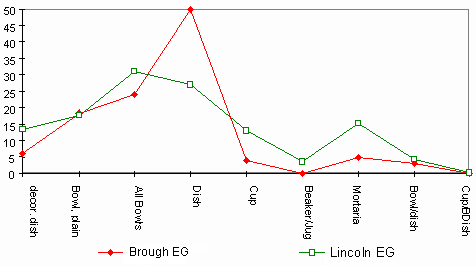
Fig.43: Samian vessels forms (percentages on sherds and vessels)
The forms represented by source are detailed by sherd count and weight, and vessel count (based on records, adjusted for sherd links) in the database.The content of the assemblage is summarised on Fig.43, using percentages based on sherd count and vessels (derived from single-vessel records, adjusted for sherd links). The percentages exclude untyped sherds and vessels which vary according to source from 3-15% which, if included, lead to distortions.

Fig.43: Samian vessels forms (percentages on sherds and vessels)
The overall content examined by source, is detailed in Table 7, percentages based on sherd count. The only differences between the use of count and maximum vessels (based on records) lay with the East Gaulish vessels, with the dishes at the slightly higher percentage at the expenses of the bowls, and the mortaria, a single vessel, much lower, probably below 1%. The sherd-count percentages have been used since the results are so close to those based on vessels, and sherds enable comparisons with other assemblages.
| South Gaul | Martres de Veyre | Central Gaul | East Gaul | |
| Bowl, decorated | 44.26 | 45.45 | 12.93 | 5.77 |
| Bowl, plain | 6.56 | 0 | 15.3 | 18.27 |
| All Bowls | (50.82) | (45.45) | (28.23) | (24.04) |
| Dish | 24.59 | 50 | 35.34 | 50 |
| Cup | 19.67 | 4.55 | 11.85 | 3.85 |
| Beaker/Jug | 0 | 0 | 0.87 | 0 |
| Mortaria | 0 | 0 | 2.59 | 4.81 |
| Bowl/dish | 1.64 | 0 | 4.53 | 2.88 |
| Cup/BDish | 0 | 0 | 0.44 | 0 |
| Untyped | 3.28 | 0 | 16.16 | 14.42 |
| Total | 100 | 100 | 100.01 | 100 |
This can be seen graphically in Fig.44.

Fig.44: Principal samian forms by source (percentage sherds)
These percentages can be compared with the samian data from Lincoln city (a sample of nearly 10,000 sherds; Darling forthcoming a). Both the small samples, from South Gaul and Les Martres de Veyre (the latter too small a sample to be significant), show unusually high percentages of decorated vessels. This peculiarity has been noted in the samian from Lincoln, in groups of South Gaulish ware occurring as very residual sherds in later Roman contexts, as is the case with the Brough sherds. The South Gaulish group is also notably low on its content of dishes and cups. Since form 29 went out of production c.AD 85 (Webster 1996, 74) the ratio of South Gaulish form 29 to form 37, 1:5, suggests that we are dealing with material which was not deposited before the 80s, or even the early 90s.
The proportion of flat-based dishes, i.e., forms 36, 79 and related types, and Curle 15 and/or 23, is noticeably high at over 10% from the Hadrianic period onwards. There is no obvious reason for this. The seemingly high percentage of East Gaulish dishes may be related.
The ratios of Central Gaulish forms 27:33 and 18/31R:31R (the latter excluding vessels which could be of either form and which would, in any case, make very little difference) are 1:3.4 and 1.8, respectively. These figures suggest a bias towards the second half of the 2nd century and, more specifically, to AD 160 onwards. Therefore, even if a peak was reached in AD 160, no very significant decline seems to have occurred before AD190 or so.
Products of the main sources, Central and East Gaul, at Brough may be usefully compared to figures from Lincoln city (sample: 5571 sherds CG; 1259 sherds EG). When the main forms for Lezoux samian are plotted, the only difference is a slightly lower percentage of cups (9%) at Brough than at Lincoln. The differences between the East Gaulish assemblages are, however, more marked, as can be seen in Fig.45.

Fig.45: Comparison of assemblages of East Gaulish forms from Brough and Lincoln (sherds percentage)
This highlights the exceptionally high percentage of East Gaulish dishes (higher on vessel count), while the cups are again lower, and the percentage of mortaria from East Gaul seems exceptionally low at 4.8%, particularly since the single vessel count would have made this even lower (compare also Brancaster 16%; Caister-on-Sea 32%). In comparison to Lincoln, the proportion of decorated bowls appears low for East Gaul at 5.8% (Lincoln 13.4%). However the scarcity of East Gaulish decorated ware should not be seen at unusual. This may be an indication of differing status between a city and Brough; there is little appreciable difference in the East Gaulish dating between the two sites. The Plotdate of the Brough samian peaks at c.AD160, significantly earlier than that from Lincoln (see below). Taking into account the earlier date emphasis and since it seems that the proportion of decorated bowls declines in the late 2nd century, c.AD160/170 (Darling 1998), the percentage of Central Gaulish bowls from Brough may also be somewhat low, despite the similar percentages overall.
On the basis of comparison with the sample from Lincoln, a city likely to have had a similar supply in the 2nd and 3rd centuries, the Brough assemblage appears to be abnormal. More data from other sites is needed to assess whether such differences are significant.
© Internet Archaeology
URL: http://intarch.ac.uk/journal/issue9/brough/potsam3.html
Last updated: Tue Nov 28 2000